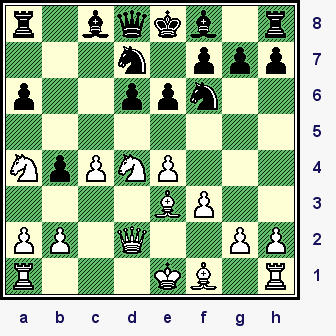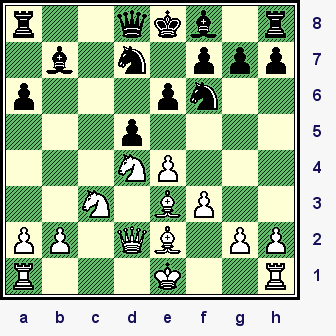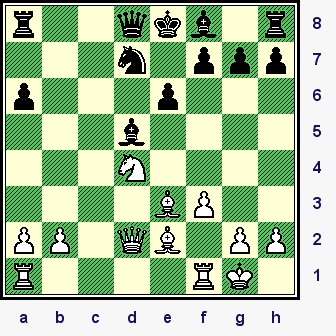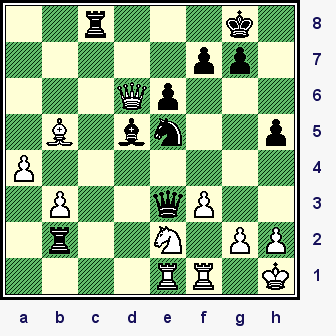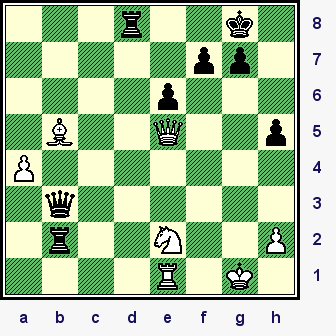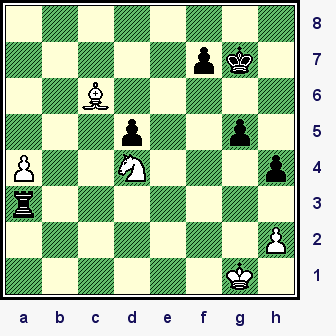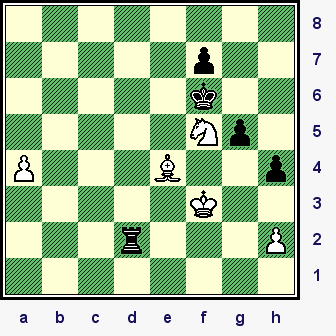All
the |
(Navigation bar
directly below.)
*******
© A.J. Goldsby, 2015.
(All rights reserved.)
****************
Click HERE
to see my
Chess Items.
****************
****************
Buy a book
from Amazon.com
(And help me out as well!)
****************
Click HERE
...
to see a list of the businesses that help to sponsor all of
my chess efforts.
" THE " Game ...
of the M-TEL 2006 Tournament?
Click
HERE
to see an explanation of the symbols that I use when annotating a chess game.
[replay
the whole game, (on a different site)]
GM
V. Anand (2803) - GM
V. Topalov (2804)
[B80]
ICT, M-Tel Masters
Sofia, BUL; (R #7)
/ 18,05,2006.
|
|
[A.J. Goldsby I]
This has to be one of the great
games of 2006, for the following reasons:
# 1.) The two best and most highly rated players in the world square off in a contest that could have a major
impact on the outcome of the tournament.
# 2.) It was played in the strongest event of the year - so far, to date.
(Category 20!)
# 3.) The normal outcome of this ending is reversed in this game.
# 4.) This was the start of a run by GM V. Topalov of four successive victories.
This amazing string of (consecutive) wins allowed the Bulgarian Champ to win the
tournament by the narrowest of margins, edging out Gata Kamsky by 1/2 a point.
# 5.) This is almost certain to become one of the most interesting and most-often
analyzed games of 2006.
**********************************************************************************************************
{The ratings are those of FIDE's. And please remember that in Round Six, Topalov had
lost to
Svidler. This placed him in FOURTH place, two full points behind the leader, American GM
Gata Kamsky ... who, after
R6, led the whole tournament with 4.5 points.}
1.e4 c5; 2.Nf3 d6; 3.d4 cxd4; 4.Nxd4 Nf6;
5.Nc3 a6;
The Najdorf Sicilian.
(Like Bobby Fischer and Garry Kasparov before him, this champ is not adverse to trying to win with the Black pieces.)
** ** ** ** ** ** ** ** ** ** ** ** ** ** ** ** ** ** ** ** ** ** ** ** ** ** ** ** ** ** ** ** ** ** ** **
Now White initiates the dreaded ... "English
Attack." [Another
game
in this opening. One more.]
(Anand uses the move order that begins with 6.f3, the normal move is 6.Be3. Of course, both of
these can simply transpose into the main lines.)
[For a detailed look at 6.Be3, see MCO-14; page # 262, columns 31-34.]
This system was played before the chess players from Great Britain began using it, but it was definitely the English players who turned it into a feared and respected weapon.
One of the earliest examples - that gained a great deal of attention in the 'chess press' - was when
Garry Kasparov, (who - at the time - was the reigning World Champion); played a
rapid match with a then-emerging star, GM Nigel
Short, in London in 1987. Nigel used this opening, and even
won one of the games with this line. Back then - I had no idea of how to classify this opening system. In the time since that match occurred, several books have been written on this variation.
6.f3 e6; ('!') (Controls d5.)
This is the standard move (here), in this position today. It shuts in the Black QB, but prevents the Knight leap of the MCO continuation.
Technically, this move takes us out of the Najdorf System and into the lines of Scheveningen Sicilian.
[See MCO-14, page # 297; columns # 19-24, and all notes.]
[ A popular reference book only considers the following line:
(</=) 6...b5!?;
7.a4! b4; 8.Nd5,
"+/=" and White is a little better.
[ See MCO-14, page # 265; column # 42, and all notes. ] ]
7.Be3 b5;
A nice "space-grabber."
8.Qd2 b4; (Too early?)
['!?']
Topalov "bumps" Anand's Knight, 8.a3 would have prevented this.
In the "old days" of chess, I am quite sure that this Pawn advance would have been condemned as premature. Here - Topalov makes sure Anand does not get out of the opening easily, at least not without being presented with a whole array of difficult choices.
[ The 'book' line here is: 8...Nbd7;
9.g4 h6;
10.0-0-0 Bb7; 11.h4 b4; 12.Na4 Qa5;
13.b3 Nc5!?;
14.a3, "~" (White has good play. Maybe
"+/=")
In this position, White has fairly good piece activity to compensate for
his Knight
that is stuck on the rim of the chess board.
There are over 175 games in the database, but easily one of the best would have
to be: GM Garry Kasparov (2849) - GM Veselin Topalov (2718);
ICT, Corus Masters {"A"}
/ (R #7) / Wijk ann Zee, NED; 2001.
{White won a model game in a grand total of 34 moves. And in Linares 1999, these
same two players had this identical position ... but with colors reversed. However,
this did not prevent Garry from winning in 61 hard-fought moves!}
]
9.Na4,
One GM ... in a recent opening article ... ... ...
offered the opinion that this was forced, after the Knight to e2, he stated that, "Black has a free hand in the center." White this might be true, Na4 has its own mix of problems, the piece seems out of
play on this square.
[ Can White try 9.Nce2!?, here? ]
9...Nbd7; ('!')
Black offers a gambit, and one that White should probably refuse.
The on-line database only shows a grand total of seven games for a search (by position) at this point in the struggle. {So the book is not of any real use here; a book published in 2003 does not even analyze this particular variation.}
10.c4!?N,
(Space, center-lock.) {See the
diagram given, just below.}
A new move, Anand wants to solve the problems of his semi-stranded cavalry unit.
|
|
r1bqkb1r/3n1ppp/p2ppn2/8/NpPNP3/4BP2/PP1Q2PP/R3KB1R b
If White grabs the button on b4, he can get into trouble, see the note just below for two possible variations.
[ (Var. # 10W01.
Or white could have tried: 10.Qxb4!? d5; 11.Qd2 dxe4; 12.Be2 Bb7; "~"
when several programs consider White to have the advantage here.
(I like Black's long-term chances, White's influence in the center is
slowly dissipating.)(Var. # 10W02.
White could have tried to grab the button in a different manner:
10.Nc6!? Qc7; 11.Nxb4 d5; 12.exd5?! Qa5!; "/+" {Diag?}
when Black is already better. (White's 12th move was a mistake.
I give this variation because it was the line that was missed by
many of the kibitzers at the club.) ]
10...bxc3; 11.Nxc3 Bb7;
12.Be2 d5!?; (Maybe - '!')
{See the
diagram given, just below.}
Topalov is pushing the envelope as hard as he can, he probably needs a win to catch Kamsky
the race for first place.
|
|
r2qkb1r/1b1n1ppp/p3pn2/3p4/3NP3/2N1BP2/PP1QB1PP/R3K2R w
Conventional wisdom holds that Black should not open up the center until after he has completed his overall development.
[ Or 12...Be7; 13.0-0 0-0; 14.Rac1, "+/=" with an advantage for White. ]
13.exd5 Nxd5; 14.Nxd5 Bxd5; 15.0-0,
"+/=" {See the
diagram given, just below.}
I clearly remember going over an old book on a tournament that was played in the late 1940's.
|
|
r2qkb1r/3n1ppp/p3p3/3b4/3N4/4BP2/PP1QB1PP/R4RK1 b
In a similar position, the first player had an advantage of 2-3 tempi out of the opening, and the annotator {in that game} stated that White was clearly better, and intimated that the win was only "a matter of time."
I wonder what this same master might have thought of this particular chess encounter?
15...Qb8!; 16.Nf5!? Qe5;
17.Ng3 Bb4!; 18.Qxb4 Qxe3+;
19.Kh1 Rb8;
Now Black's King is stuck in the center, it appears that Topalov may have outsmarted himself.
20.Qd6!? Rb6!;
Black could have tried to force an exchange of Queens here, but that may have only led to a draw.
21.Qc7 Rc6; 22.Qb7!? Rc2!?;
Going for the win, Fritz seems to think that 22...Qb6 gives Black a small, but solid edge.
23.Qxa6 0-0; 24.b3!?, hmmm
(The simplest, but it also is a little passive and hands over the initiative to his opponent.)
[ The box likes: 24.Qa4, "+/=" here. ]
24...Ne5;
"<=>" ("compensation")
Now Black has plenty of play to make up for his being minus just one Pawn.
25.Rae1!? Qd2; 26.Rd1 Qf4!;
(This prevents White from challenging Black's control of the c-file.)
27.Bb5 h5!; 28.Ne2,
This was forced, if White were to thoughtlessly grab the Pawn on h5, he loses horribly.
[ Completely wrong was:
</= 28.Nxh5? Qh4;
29.Ng3?? Ng4!;
30.h3 Qxg3; "-/+"
and White will not be able to avoid a quick mate.
]
28...Qe3; 29.a4 Rb2;
Black will win back a button.
(29...h4; was worth a look.)
Now maybe White should grab the c-file, before his wily opponent prevents this opportunity.
30.Qd6!? Rc8;
Now Black threatens to simply double his Rooks on the seventh rank ...
31.Rde1, (Key position.)
{See the
diagram given, just below.}
A climax has been reached.
|
|
2r3k1/5pp1/3Qp3/1B1bn2p/P7/1P2qP2/1r2N1PP/4RR1K b
Strangely, the computer evaluates this position as close to equal, but Black may now have a winning combination. (Probably the results of this continuation are too far ahead for the computer to grasp the real power behind Black's idea here.)
[ But not: </= 31.Rfe1? Nxf3!; "/+" etc. ]
31...Nxf3!!; (KA-BOOOM!!!!!)
Black will wind up in an endgame where a lone Rook must face two hostile minor pieces.
Many of the other classic games always seem to show the minor pieces coming out on top, so its nice to see one example of the Rook winning this endgame duel.
The next few moves are all pretty much forced, Anand has almost no choice at all.
32.gxf3 Bxf3+; 33.Rxf3 Qxf3+;
34.Kg1 Qe3+;
Topalov tosses in an extra check (or two); probably so that he can be sure of making the time control.
35.Kf1 Qf3+; 36.Kg1 Qxb3;
37.Qe5 Rd8!; (Material balance?)
{See the
diagram given, just below.}
Black - once again - is making it clear he wants his pigs to set up house on their seventh rank.
|
|
3r2k1/5pp1/4p3/1B2Q2p/P7/1q6/1r2N2P/4R1K1 w
I am currently reading the book, "Turning Advantage Into Victory In Chess," (by GM Andy Soltis); and it continues to make a big impression on me.
As Soltis makes the point - several times in his book - its not what comes off the board that matters, it is what stays on. To evaluate this position, White's insecure King, isolated Pawns, and pieces that work poorly together are no match for Black's well-coordinated forces. (You should also take notice of Black's large pawn mass and secure King as well.)
38.Qc3 Qxc3;
This is good ...
(I think Topalov was very short of time when he played this move.)
[ Also possible was: (>/=) 38...Rd1!?; for Black in this position. ]
39.Nxc3 h4; "=/+" 40.Re4 Rb3;
41.Ne2 g5; 42.Re5 Rd5; ('!')
Black will surrender one Pawn ... in order to reach the endgame.
Supposedly, in endgames where a "Rook-plus-one-Pawn" struggles against two minor pieces, the superior battle forces usually win out. (Here is a clear exception to that rule.)
43.Rxd5 exd5; 44.Bc6 Ra3; 45.Nd4 Kg7; {See the
diagram given, just below.}
The King is a fighting piece, and should always be so used; especially in simplified endings where the threat of a surprise mate is small.
|
|
8/5pk1/2B5/3p2p1/P2N3p/r7/7P/6K1 w
White's position is critical, after several days of analysis, I no longer believe that it will be possible for Anand to save his game from this point on.
46.Bxd5, ('?!' - GM Mikhail Marin)
GM M. Marin criticizes this move, yet I am at a loss to divine what move would be clearly
better. (46.Ne2,
f5; "/+" is clearly much better for Black, and may be even worse than the actual game continuation.) Further - Bxd5 is the first choice of Fritz 9.0 after half an hour of machine time
...
In general, the weaker side should always trade as many Pawns as possible. Further, I strongly feel that once Black gets his Pawns moving, White is lost anyway. (Anand seems to also realize this, and battles heroically to prevent his opponent from mobilizing his infantry ...)
[ The continuation after the following moves:
(</=) 46.Kf2!? Kf6; 47.Nf3 Ra2+;
is clearly better for Black, ("/+") and I doubt that White could save
his game
in this variation. ]
46...Rd3!; (Maybe - '!!') (switch-up)
After leading Anand to believe that the QRP was the target all along, the alert Topalov spots a
complex move sequence that allows him to win the other pawn! (Delightful!!)
[ Both Fritz ... and the average GM ...
would probably have played
46...Rxa4;
"=/+" in this position. ]
Now comes a lot of dancing around. To the common player at the club, Topalov is making little or no
(real) progress here - which just goes to show how difficult this ending really is.
47.Nf5+ Kf6; 48.Be4 Rd1+; 49.Kg2 Rd2+; 50.Kf3[],
{See the
diagram given, just below.}
White had no choice here.
|
|
8/5p2/5k2/5Np1/P3B2p/5K2/3r3P/8 b
The alternatives were clearly worse for Anand. {See the note given just below here.}
[ Losing for White was: </= 50.Kg1? Ke5; 51.Bb1 Rd1+; ("-/+")
when Black wins a piece.Or </= 50.Kh3? Ke5; 51.Bb1 Rb2; 52.Bd3 Kf4!; 53.Nh6 Rb3; ("-/+")
when Black will also win without any problem. ]
50...Rxh2; "/+"
Now to win, Black need only to complete the following steps:
a.) Get his Rook behind the (White)
QRP.
b.) Move his King up.
c.) Get the Pawns rolling.
51.Ne3 Ra2; 52.Bc6 Ra3;
53.Kf2 Ra1; 54.Bd7,
Anand tries to prevent Topalov from advancing his RP on the h-file.
[ Or </= 54.Kg2!? Ke5; "-/+" ]
54...Ke5; 55.Kf3 Ra3!;
56.Kf2 Ke4;
White is now forced to do something he really would like to avoid ...
[ Care is need in every position, i.e.,
56...Kd4??; 57.Nc2+,
forks Topalov's King and Rook, (and wins for
Anand). ]
** ** ** ** ** ** ** ** ** ** ** ** ** ** ** ** ** ** ** ** ** ** ** ** ** ** ** ** ** ** ** ** ** ** ** **
(Now if White checks on f5, then Black moves his King to f4, and the first player will lose a piece.)
57.Bc6+ Kf4; 58.Ng2+ Ke5;
Game over!
(Now Anand cannot prevent ...f7-f5; and the subsequent march of the mass of three
connected, passed pawns.)
59.Ne3 Ra2+; 60.Kf3 f5;
61.Bd7 h3; "-/+" Anand Resigns.
A truly exemplary endgame, White made no noticeable mistakes in this phase of the struggle.
And Topalov's play here - in the final stages - was as close to perfection as humanly possible.
With this victory, Topalov began a march that wound up in the winner's circle.
(Topalov's
performance rating for the last four rounds of this event was over 3050!!!)
[I began my analysis the same day that this game was posted on the Internet, but did
not complete my work until many days later. Please consult the excellent ChessBase
article,
(http://www.chessbase.com/newsdetail.asp?newsid=3116); to read GM Mikhail Marin's
analysis of this exciting contest.]
Copyright (c) A.J. Goldsby, 2006. All rights reserved.
0 - 1
Further Study
For another game that features White playing the set-up with Pawns on e4, f3 and a later g2-g4, The White QB on e3, The WQ on d2, castling Q-side, (etc.); and Black (also) plays an early ...b7-b5; please see the GM contest: Wang Hao (2610) - G. Vescovi (2619); GM Scheveningen Tournament / 2006. This game will be briefly annotated as one of the downloadable games for my July, 2006; "Game of The Month."
The analysis for this page was prepared with the excellent programs, ChessBase 8.0 and ChessBase 9.0.
The HTML was polished with several different tools and programs, (mostly FP) ... the text was checked for spelling with MS Word.
The diagrams were created with the program, Chess Captor 2.25.
******************************************************************************
This page was first posted on: Tuesday; May 23rd, 2006. Page last edited: Monday, April 14, 2014 11:22 AM .
[Home] [Site Map] [News page] [Annotated games, # 2]
Copyright (©) A.J. Goldsby, 2014. All rights reserved.
